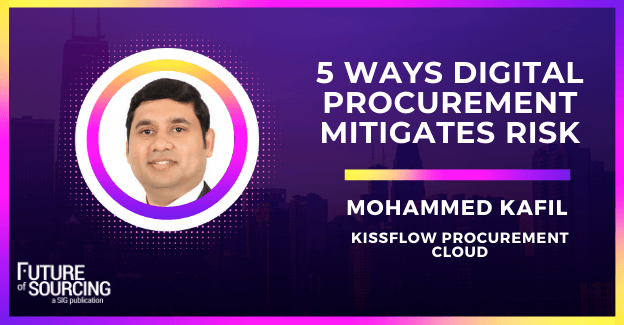Procurement teams are facing risks on multiple fronts and a cutting-edge technology solution is no longer a nice to have but a requirement, says Mohammed Kafil, a procurement consultant with Kissflow Procurement Cloud. He outlines five common risks faced by procurement teams and examples of how technology can help you avoid those risks going forward.
Nothing in business is risk-free. Every department in a company needs to deal with risk daily.
Risk management appears to be a simple concept, yet it is a highly complicated aspect of organizational and procurement strategy.
We all know that procurement must be dependable and secure. Hence, it's crucial to control and mitigate the variety of risks connected with business operations to achieve success.
What is Procurement Risk Management?
Procurement risk management aims to foresee potential threats and safeguard organizations from risks during the procurement process. As a result of risk management, organizations are able to assure the smooth and effective functioning of their purchasing and supply processes.
Even though the actual risk management process may vary from one business to another, few standard methods exist. As a result, the procedure may be something you already do without even realizing it.
If you have an excellent procurement risk management plan in place, your firm will save vast amounts of money and prevent setbacks. In addition, it will keep the procurement process running smoothly and efficiently.
Below we'll discuss some common procurement risks and how you can mitigate them with digital procurement tools.
Common Risks Faced by Procurement Teams
In today's world, risk management in procurement has even more significant implications for a company's future performance and reputation. Some of the common risks associated with the procurement process include the following:
Overspending
Having a clear understanding of your requirements – how and who will meet them – is crucial to the success of any supply chain.
Many difficulties can occur throughout the procurement process if there is no clear visibility of the expenditures made by each employee. In a conventional procurement system, employees spend money deliberately without knowing whether the purchase is necessary or not.
Aside from being inconvenient, this can lead to unauthorized purchases and additional expenses, and wastage of valuable time. Furthermore, it will be impossible to connect budgets to actual purchase behavior, which will result in an inadequate audit trail, exposing you to severe financial risk.
Disorganized Supplier Management
A disorganized supplier management system involving extensive paperwork and manual processes can prove to be a significant risk throughout your organization.
Today, many companies are still using outdated sheets to manage different suppliers and inventory, making the process inefficient because of limited features. It also restricts companies from making the right decisions while choosing suppliers.
If you are not onboarding the right suppliers or managing their accounts and payments effectively, you might lose a profitable supplier and suffer huge losses.
For example, your company has a supplier that provides you with goods at lower prices than others. Due to the ineffective internal processing and approval system, their payments get delayed every month.
As a result, they switch to other buyers next time, providing them with a competitive edge over your company.
Manual Processing
Manual entry, processing and sign-off procedures slow down the procurement cycle, causing late payment penalties, lost documents and even endangering your supplier relationships.
Furthermore, any system that relies on paper and human data entry is prone to error – resolving the issue results in higher invoicing resolution costs and lower employee productivity.
Inadequate Need Analysis
The procurement process begins when a department or business unit recognizes a need for a product or service. The risks are clear: exaggeration or underestimation of the necessity, unrealistic timelines, budgetary constraints and poorly conceived requirements.
While it is self-evident that these risks cost time and money, the actual issue is the ripple effect. Incorrect forecasting and budgeting from the start may lead to a series of bad decisions down the road.
You may, for example, purchase far too many of a single product or purchase unnecessary goods that might not even meet your needs.
Inappropriate Use of Talented resources
In a survey conducted by DHL Supply Chain, nearly 70% of survey respondents said that a “perceived lack of potential for career growth” and “perceived status of the supply chain as a profession” have a high or very high influence on their ability to identify, attract and retain talent.
Because there are significant skill shortages for supply chain experts, you must plan to mitigate the risk of wasting talented resources on mundane tasks. Otherwise, your procurement process will be slowed by a lack of employees.
How to Mitigate Risks with Digital Procurement
Digital procurement can be defined as the process of enhancing the procurement function with the use of digital technology. By leveraging the latest technology available, CPOs can mitigate the risks associated with procurement.
Below are some examples of how you can avoid risks with the help of digital procurement software:
1. Analyze Your Spending Patterns
Instead of relying on budgets that don't correspond to actual spending patterns, you can use the contemporary automation technologies that digital procurement tools provide.
You can track and analyze transaction data for each purchase and examine use patterns using spend analytics. In addition, it provides you with helpful information about how to improve and adapt your company's procurement strategy.
2. Streamlined Supplier Management
Digital procurement solutions enable easy to use supplier portals and simplify supplier evaluation and administration, substantially reducing supply chain risk.
By defining and assigning responsibilities for each element of the procurement process – such as requests, approvals and purchases – digital procurement software may limit or eliminate unnecessary expenditures.
Another benefit of digital procurement solutions is that it streamlines the strategic sourcing of goods that can help in negotiating better agreements for your business.
3. Automated and Digitized Document Management
With the help of digitized document management, you can gather, organize and store data in a systematic way. Moreover, automated entries and data extraction are less prone to errors and mistakes, which reduce data inaccuracy.
Digitization of documents will save your employees valuable time and provide data consistency throughout the organization. Furthermore, it will cut down paper and storage costs.
4. Collaborative Interface
A collaborative interface allows users to track the journey of every purchase. Moreover, this helps in audit and verifies all the transactions made by the employees.
Stakeholders can monitor what's going on at every level of their supplier tier, allowing them to predict and avoid problems before they happen. Entailing a journey toward transparency and mitigating procurement risks may provide organizations with several benefits.
In addition to this, a collaborative system can help break data silos and avoid risks that can arise from miscommunication within and between the departments inside an organization. With the clarification of queries at request level with ease, any misunderstanding can be mitigated. This also provides a complete visibility into the entire process.
Data sourcing can be automated to save time and money while also increasing company efficiency. Data automation reduces errors by validating data and ensuring that the data is delivered in an organized way to create data consistency throughout the organization
5. Talent Management
Digital procurement software helps free up your staff by reducing dull, repetitive tasks that might take up a lot of time. When mundane tasks are replaced by technology, employees deal with challenging tasks that keep them motivated and allow them to grow in their field.
Moreover, digitizing your procurement processes can help you utilize your staff in crucial areas where human interaction is needed.
Conclusion
A growing number of companies now rely heavily on procurement, and a procurement risk mitigation plan is essential during the process. There's no denying that digital procurement and the application of cutting-edge technology may help mitigate risk.
Given the current state of the economy, an efficient digital procurement strategy can help your organization’s bottom line by lowering expenses and increasing efficiency and transparency.








